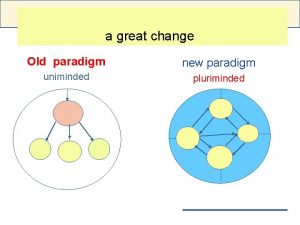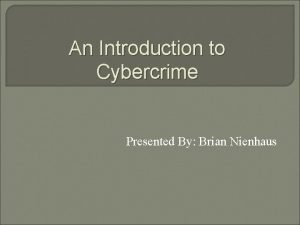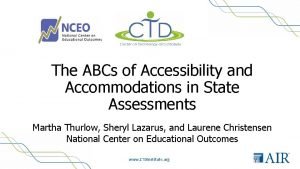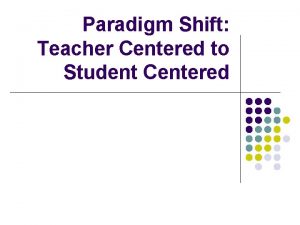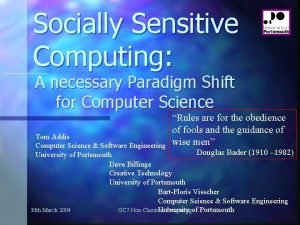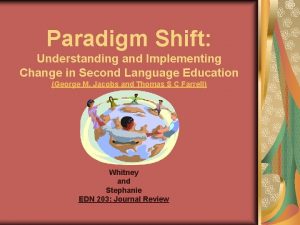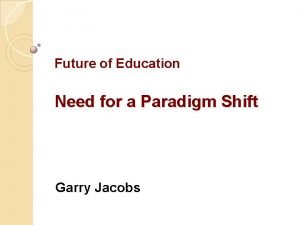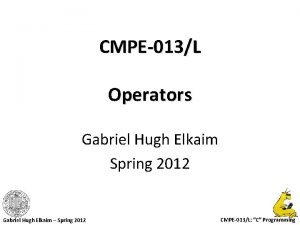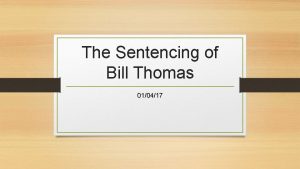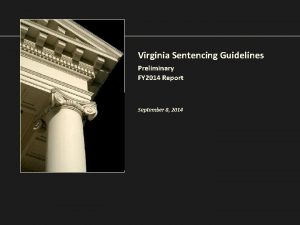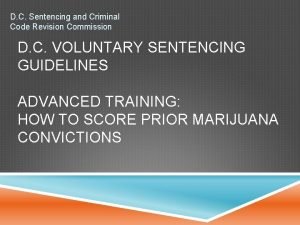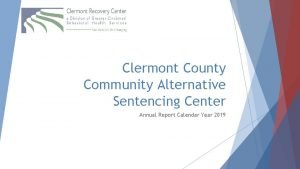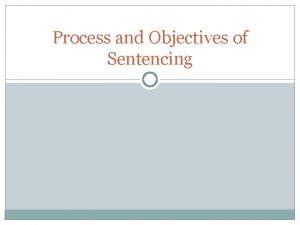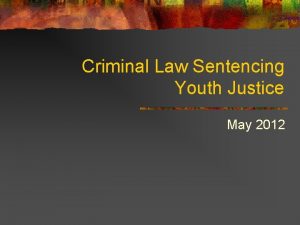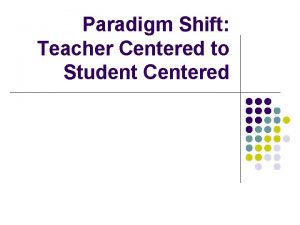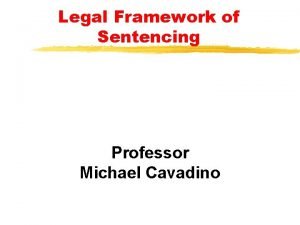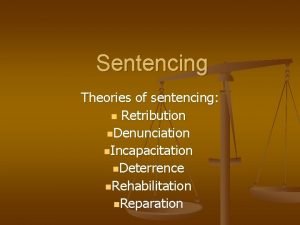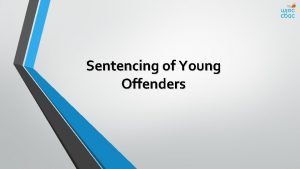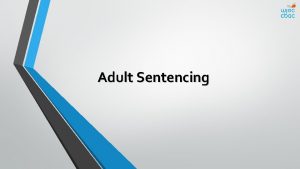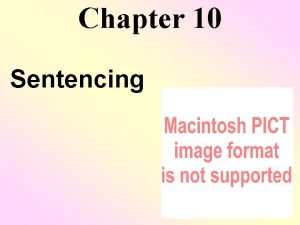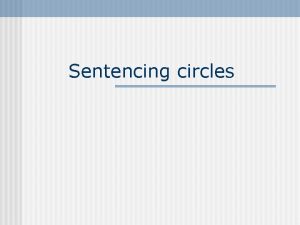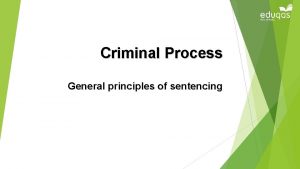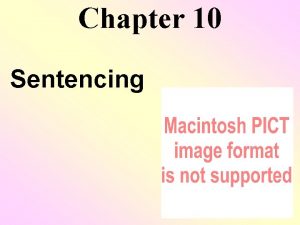NSW Sentencing Law A Paradigm Shift DCJ Dina








![R v Pullen [2018] NSWCCA 264 Per Harrison J (Johnson J and Schmidt J R v Pullen [2018] NSWCCA 264 Per Harrison J (Johnson J and Schmidt J](https://slidetodoc.com/presentation_image/1c64f629075d60c563249f3903e07d1b/image-9.jpg)
![R v Pullen [2018] NSWCCA 264 • [86] The prioritisation of the consideration of R v Pullen [2018] NSWCCA 264 • [86] The prioritisation of the consideration of](https://slidetodoc.com/presentation_image/1c64f629075d60c563249f3903e07d1b/image-10.jpg)
![R v Pullen [2018] NSWCCA 264 • [89] The result of these amendments is R v Pullen [2018] NSWCCA 264 • [89] The result of these amendments is](https://slidetodoc.com/presentation_image/1c64f629075d60c563249f3903e07d1b/image-11.jpg)

![Perkins v R [2018] NSWCCA 62 • Hoeben CJ at [42] On my reading Perkins v R [2018] NSWCCA 62 • Hoeben CJ at [42] On my reading](https://slidetodoc.com/presentation_image/1c64f629075d60c563249f3903e07d1b/image-13.jpg)
![• Further, Fullerton J at [100] stated White JA noted at [77], the • Further, Fullerton J at [100] stated White JA noted at [77], the](https://slidetodoc.com/presentation_image/1c64f629075d60c563249f3903e07d1b/image-14.jpg)
![Judge v R [2018] NSWCCA 203 White JA, causal connection not required, effects of Judge v R [2018] NSWCCA 203 White JA, causal connection not required, effects of](https://slidetodoc.com/presentation_image/1c64f629075d60c563249f3903e07d1b/image-15.jpg)
![Bugmy v The Queen [2013] HCA 37 • After referring to the judgment of Bugmy v The Queen [2013] HCA 37 • After referring to the judgment of](https://slidetodoc.com/presentation_image/1c64f629075d60c563249f3903e07d1b/image-16.jpg)
![• [43]… The experience of growing up in an environment surrounded by alcohol • [43]… The experience of growing up in an environment surrounded by alcohol](https://slidetodoc.com/presentation_image/1c64f629075d60c563249f3903e07d1b/image-17.jpg)
![Advancing Evidence of Disadvantage [41] ……. the appellant’s submission that courts should take judicial Advancing Evidence of Disadvantage [41] ……. the appellant’s submission that courts should take judicial](https://slidetodoc.com/presentation_image/1c64f629075d60c563249f3903e07d1b/image-18.jpg)







![Muldrock v The Queen (2011) 244 CLR 120 • The full bench at [27] Muldrock v The Queen (2011) 244 CLR 120 • The full bench at [27]](https://slidetodoc.com/presentation_image/1c64f629075d60c563249f3903e07d1b/image-26.jpg)
![Yun v R [2017] NSWCCA 317 • Latham J and Bellew J at [47] Yun v R [2017] NSWCCA 317 • Latham J and Bellew J at [47]](https://slidetodoc.com/presentation_image/1c64f629075d60c563249f3903e07d1b/image-27.jpg)
![Tepania v R [2018] NSWCCA 247 Per Johnson J (Payne JA and Simpson AJA Tepania v R [2018] NSWCCA 247 Per Johnson J (Payne JA and Simpson AJA](https://slidetodoc.com/presentation_image/1c64f629075d60c563249f3903e07d1b/image-28.jpg)
- Slides: 28

NSW Sentencing Law: A Paradigm Shift? DCJ Dina Yehia SC March 2019

Crimes (Sentencing Procedures) Act Section 5 not crossed - A Conditional Release Order with (s 9(1)(a)) or without conviction (s 10(1)(b)). - A Community Corrections Order for up to three years (s 8(1)). Conditions: - The standard conditions are that the offender not commit further offences, and appear before the court when called upon to do so. - Both a CRO and CCO may include supervision by Community Corrections. - Additional conditions may be imposed requiring counselling, drug and alcohol treatment, abstinence from drugs and alcohol, etc.

Crimes (Sentencing Procedures) Act Section 5 crossed - Sentenced to a term of imprisonment to be served by way of an Intensive Corrections Order. - Up to two years where a single offence (s 7(1)), or three years for an aggregate term (s 68)). - Certain offences excluded (s 67): Murder/manslaughter Prescribed sexual offence Contravene serious Contravene public Crime prevention order safety order Terrorism (state/cth) Offences involving discharge of firearm Including: any offence that includes the commission of, or an intention to commit; an offence of attempting or conspiring to commit

What is a Public Safety Order? Law Enforcement (Powers and Responsibilities Act) 2002, s 87 Q A public safety order is an order made by a senior police officer that prohibits a specified person (or persons belonging to a specified class of persons) from: - (a) attending a specified public event (including entering, or being present at, premises being used in connection with the public event), or - (b) entering, or being present at, specified premises or other specified area at any time during a specified period. What is a Serious Crime Prevention Order? Crimes (Serious Crime Prevention Orders) Act 2016, Part 2 s 5(1) A court may, on application, make an order • against an adult person convicted of a serious offence, or not convicted of (i. e. acquitted or not charged); • If the court is satisfied that there are reasonable grounds to believe that the making of the order would protect the public by preventing, restricting or disrupting involvement by the person in serious crime related activities.

Crimes (Sentencing Procedures) Act Conditions for ICO’s - The standard conditions are that the offender not commit any offence, appear before the court when called on, and submit to the supervision/guidance of Community Corrections (s 73). - At least one additional condition must be imposed (s 73 A): home detention, electronic monitoring, curfew, community service, rehabilitation/treatment, abstention from drugs/alcohol, non association, place restrictions. - Any further condition the court thinks appropriate

Crimes (Sentencing Procedures) Act Community Safety (s 66) (1) Community safety must be the paramount consideration when the sentencing court is deciding whether to make an intensive correction order in relation to an offender. (2) When considering community safety, the sentencing court is to assess whether making the order or serving the sentence by way of full-time detention is more likely to address the offender’s risk of reoffending. (3) When deciding whether to make an intensive correction order, the sentencing court must also consider the provisions of section 3 A (Purposes of sentencing) and any relevant common law sentencing principles, and may consider any other matters that the court thinks relevant.

Crimes (Sentencing Procedures) Act Domestic Violence Offenders (s 4 B) • (1) An intensive correction order must not be made in respect of: (a) a sentence of imprisonment for a domestic violence offence, or (b) an aggregate sentence of imprisonment for 2 or more offences, any 1 or more of which is a domestic violence offence, unless the sentencing court is satisfied that the victim of the domestic violence offence, and any person with whom the offender is likely to reside, will be adequately protected (whether by conditions of the intensive correction order or for some other reason). • (3) Before making a community correction order or conditional release order in respect of a person whom the sentencing court finds guilty of a domestic violence offence, the court must consider the safety of the victim of the offence.

Crimes (Sentencing Procedure) Amendment (Sentencing Options) Act 2017 • “New section 66 of the Crimes (Sentencing Procedure) Act will make community safety the paramount consideration when imposing an intensive correction order on offenders whose conduct would otherwise require them to serve a term of imprisonment. Community safety is not just about incarceration. Imprisonment under two years is commonly not effective at bringing about medium- to long-term behaviour change that reduces reoffending. Evidence shows that community supervision and programs are far more effective at this. That is why new section 66 requires the sentencing court to assess whether imposing an intensive correction order or serving the sentence by way of full-time detention is more likely to address the offender's risk of reoffending”: NSW Legislative Assembly, Second Reading Speech, 11 October 2017 at 2 (emphasis added).
![R v Pullen 2018 NSWCCA 264 Per Harrison J Johnson J and Schmidt J R v Pullen [2018] NSWCCA 264 Per Harrison J (Johnson J and Schmidt J](https://slidetodoc.com/presentation_image/1c64f629075d60c563249f3903e07d1b/image-9.jpg)
R v Pullen [2018] NSWCCA 264 Per Harrison J (Johnson J and Schmidt J agreeing): • [84] In determining whether an ICO should be imposed, s 66(1) makes “community safety” the paramount consideration. The concept of “community safety” as it is used in the Act is broad. As s 66(2) makes plain, community safety is not achieved simply by incarcerating someone. It recognises that in many cases, incarceration may have the opposite effect. It requires the Court to consider whether an ICO or a full-time custodial sentence is more likely to address the offender’s risk of re-offending. The concept of community safety as it is used in the Act is therefore inextricably linked with considerations of rehabilitation. It is of course best achieved by positive behavioural change and the amendments recognise and give effect to the fact that, in most cases, this is more likely to occur with supervision and access to treatment programs in the community.
![R v Pullen 2018 NSWCCA 264 86 The prioritisation of the consideration of R v Pullen [2018] NSWCCA 264 • [86] The prioritisation of the consideration of](https://slidetodoc.com/presentation_image/1c64f629075d60c563249f3903e07d1b/image-10.jpg)
R v Pullen [2018] NSWCCA 264 • [86] The prioritisation of the consideration of community safety as the “paramount consideration” necessarily means, however, that other considerations, including those enunciated in s 3 A of the Act, become subordinate. • [87] This is likely to occur most frequently in the case of a young offender with limited or no criminal history and excellent prospects of rehabilitation. In every case, however, a balance must be struck and appropriate weight must be given to all relevant factors which must be taken into account in arriving at the sentence, by way of the instinctive synthesis discussed in Markarian v The Queen (2005) 228 CLR 357; [2005] HCA 25 at [51]
![R v Pullen 2018 NSWCCA 264 89 The result of these amendments is R v Pullen [2018] NSWCCA 264 • [89] The result of these amendments is](https://slidetodoc.com/presentation_image/1c64f629075d60c563249f3903e07d1b/image-11.jpg)
R v Pullen [2018] NSWCCA 264 • [89] The result of these amendments is that in cases where an offender’s prospects of rehabilitation are high and where their risk of reoffending will be better managed in the community, an ICO may be available, even if it may not have been under the old scheme. The new scheme makes community safety the paramount consideration. In some cases, this will be best achieved through incarceration. That will no doubt be the case where a person presents a serious risk to the community. In other cases, however, community protection may be best served by ensuring that an offender avoids gaol.

Disadvantage: Is a Causal link to Offending Necessary?
![Perkins v R 2018 NSWCCA 62 Hoeben CJ at 42 On my reading Perkins v R [2018] NSWCCA 62 • Hoeben CJ at [42] On my reading](https://slidetodoc.com/presentation_image/1c64f629075d60c563249f3903e07d1b/image-13.jpg)
Perkins v R [2018] NSWCCA 62 • Hoeben CJ at [42] On my reading of Bugmy v R it is not sufficient to simply establish some elements of a deprived upbringing and/or the presence of domestic violence unless there is evidence or it can be properly inferred that such exposure “may explain the offender’s recourse to violence when frustrated such that the offender’s moral culpability for the inability to control that impulse may be substantially reduced. ” • However plurality held at [77] Nor did the plurality say that if such a background of deprivation is established it will only be a mitigating factor if a causal link between the background of deprivation and the offence is established. Gageler J said (at [56]) that “The weight to be afforded to the effects of social deprivation in an offender’s youth and background is in each case a matter for individual assessment. ”
![Further Fullerton J at 100 stated White JA noted at 77 the • Further, Fullerton J at [100] stated White JA noted at [77], the](https://slidetodoc.com/presentation_image/1c64f629075d60c563249f3903e07d1b/image-14.jpg)
• Further, Fullerton J at [100] stated White JA noted at [77], the plurality in Bugmy did not say that deprivation will only be a mitigating factor lessening the moral culpability of the offender if it is causally linked to the offending but, rather, to adopt the approach of Gageler J at [56], the effects of social deprivation and its weight in the sentencing exercise is a matter for individual assessment. [102] While the weight of the applicant’s life experience in a violent household with a drunk man in the overall assessment of his subjective circumstances might not ultimately be significant in the sentencing result, for the reasons outlined above, it was an error for the sentencing judge to discount it as irrelevant because there was no evidence of it being causally related to his offending.
![Judge v R 2018 NSWCCA 203 White JA causal connection not required effects of Judge v R [2018] NSWCCA 203 White JA, causal connection not required, effects of](https://slidetodoc.com/presentation_image/1c64f629075d60c563249f3903e07d1b/image-15.jpg)
Judge v R [2018] NSWCCA 203 White JA, causal connection not required, effects of social deprivation and its weight in sentencing matter for individual assessment at 30: “[77] In Bugmy the High Court neither endorsed Mr Bugmy’s submission (at 581) that no causal connection between the offender’s aboriginality and the commission of the offence was needed, nor the submission of the Crown (at 579) that for systemic factors establishing profound social deprivation to diminish the moral blameworthiness of a particular offence, they must be causally linked. The plurality (French CJ, Hayne, Crennan, Kiefel, Bell and Keane JJ) said that if an offender seeks to rely on his or her background of deprivation in mitigation of sentence, he or she needs to point to material tending to establish that background (at [41]), but did not say that if such background of deprivation is established it will (as distinct from may) be a mitigating factor. Nor did the plurality say that if such a background of deprivation is established it will only be a mitigating factor if a causal link between the background of deprivation and the offence is established. Gageler J said (at [56]) that ‘The weight to be afforded to the effects of social deprivation in an offender’s youth and background is in each case a matter for individual assessment. ’
![Bugmy v The Queen 2013 HCA 37 After referring to the judgment of Bugmy v The Queen [2013] HCA 37 • After referring to the judgment of](https://slidetodoc.com/presentation_image/1c64f629075d60c563249f3903e07d1b/image-16.jpg)
Bugmy v The Queen [2013] HCA 37 • After referring to the judgment of Woods J in Fernando (see below), the High Court in Bugmy said at [40]: [40] Of course, not all Aboriginal offenders come from backgrounds characterised by the abuse of alcohol and alcohol -fuelled violence. However, Wood J was right to recognise both that those problems are endemic in some Aboriginal communities, and the reasons which tend to perpetuate them. The circumstance that an offender has been raised in a community surrounded by alcohol abuse and violence may mitigate the sentence because his or her moral culpability is likely to be less than the culpability of an offender whose formative years have not been marred in that way.
![43 The experience of growing up in an environment surrounded by alcohol • [43]… The experience of growing up in an environment surrounded by alcohol](https://slidetodoc.com/presentation_image/1c64f629075d60c563249f3903e07d1b/image-17.jpg)
• [43]… The experience of growing up in an environment surrounded by alcohol abuse and violence may leave its mark on a person throughout life. Among other things, a background of that kind may compromise the person's capacity to mature and to learn from experience. It is a feature of the person's make-up and remains relevant to the determination of the appropriate sentence, notwithstanding that the person has a long history of offending. [44] Because the effects of profound childhood deprivation do not diminish with the passage of time and repeated offending, it is right to speak of giving "full weight" to an offender's deprived background in every sentencing decision.
![Advancing Evidence of Disadvantage 41 the appellants submission that courts should take judicial Advancing Evidence of Disadvantage [41] ……. the appellant’s submission that courts should take judicial](https://slidetodoc.com/presentation_image/1c64f629075d60c563249f3903e07d1b/image-18.jpg)
Advancing Evidence of Disadvantage [41] ……. the appellant’s submission that courts should take judicial notice of the systemic background of deprivation of Aboriginal offenders cannot be accepted. It ……. . is antithetical to individualised justice ……. In any case in which it is sought to rely on an offender’s background of deprivation in mitigation of sentence, it is necessary to point to material tending to establish that background.

Evidence Gladue reports (Canada) may address: • • The offender’s criminal history; Family information; Relationships; Any past psychological assessment; Any substance abuse history; Any history of abuse or neglect with the family home, including abuse physical emotional level or sexual and any exposure to domestic violence; Any institutional history; Any rehabilitation programs attempted and completed; • Current charges & any remorse/ acceptance of responsibility; • Details of past criminal behaviour/any time in gaol; • Education & employment history; • Health and well-being; • Any suicide or self-harm history; • Other major life experiences; • Spirituality and culture; • Hobbies and interests; • Dreams and goals; • Current circumstances (residential, family, financial).

Evidence Bugmy features to be adduced if available: Community information Substance abuse history Family information Current charges Abuse history Criminal record Institutional history Health and well-being Relationships Current circumstances Psychological assessments Other matters (incl. education/ employment history, other major life experiences)

Evidence by Affidavit evidence from: • Offender • Family members • Field officers • Solicitors (Justice Health, etc)

Studies/Academic Research Indigenous disadvantage ALRC, Pathways to Justice – Inquiry into the Incarceration Rate of Aboriginal and Torres Strait Islander People (2018) Intergenerational trauma, criminogenic effects of incarceration Over-represented and Overlooked: The Crisis of Aboriginal and Torres Strait Islander Women’s Growing Over-imprisonment (2017) generational impacts of incarceration Productivity Commission, Overcoming Indigenous Disadvantage (2011) poor/worsening numeracy and literacy 2008– 2012 Little Children Are Sacred Report (2007) childhood exposure to violence BOCSAR, ‘The Effect of Arrest on Indigenous Employment Prospects’ (1999) prior contact with criminal justice system Mc. Causland Vivian, ‘Factors Affecting Crime Rates in Indigenous Communities in NSW: A Pilot Study in Wilcannia and Menindee’ (2009) frequent deaths in community, alcohol use & lack of local services

Studies/Academic Research Day et al, ‘Indigenous Family Violence: An Attempt to Understand the Problems and Inform Appropriate and Effective Responses to Criminal Justice Intervention’ (2012) Psychiatry, Psychology and Law 104 childhood exposure to violence and drug/alcohol abuse triggers for adult violence; impacts of government intervention enforcing feelings of powerlessness: 109– 10 HREOC, Bringing Them Home Report (1997) criminogenic impacts of entering justice system at a young age: ch 24 ABS, ABS 4275. 0 – Aboriginal and Torres Strait Islander Wellbeing: correlation between A Focus on Children and Youth (2011) experience of physical/ psychological violence & arrested youth Doing Time – Time for Doing: Indigenous Youth in the Criminal Justice System (2011) legacy of profound distrust towards police: 196– 7

Studies/Academic Research Other forms of disadvantage, Australian Human Rights Commission, Children’s Rights Report 2015 (2015) Childhood exposure to domestic violence Children’s Exposure to Domestic and Family Violence’ (CFCA Paper No. 36, December 2015) Learned hostile behaviours & poor emotional regulation Royal Australian and New Zealand College of Psychiatrists sub to AHRCA, Examination of Children Affected by Family Violence (17 June 2015) Exposure to DV may increase risk of similar behaviours in adulthood: 11 Lorana Bartels, Emerging Issues in Domestic/Family Violence Children exposed to DV at Research (Research in Practice Report No 10, Australian Institute of greater risk of substance Criminology, April 2010) abuse & criminal behaviour Kelly Richards, ‘Children’s Exposure to Domestic Violence in Australia’ (Trends & Issues in Crime & Criminal Justice No 149, Australian Institute of Criminology, June 2011) Violence, alcohol and drug abuse & depression as behavioural impacts of exposure to DV Forgotten Australians: A Report on Australians Who Experienced Institutional or Out-Of-Home Care as Children (2004) Ch 6: ‘Life Long Impact of Out of Home Care’

Assessing Objective Seriousness
![Muldrock v The Queen 2011 244 CLR 120 The full bench at 27 Muldrock v The Queen (2011) 244 CLR 120 • The full bench at [27]](https://slidetodoc.com/presentation_image/1c64f629075d60c563249f3903e07d1b/image-26.jpg)
Muldrock v The Queen (2011) 244 CLR 120 • The full bench at [27] said: “Section 54 B(2) and s 54 B(3) oblige the court to take into account the full range of factors in determining the appropriate sentence for the offence. In so doing, the court is mindful of two legislative guideposts: the maximum sentence and the standard non-parole period. The latter requires that content be given to its specification as ‘the non-parole period for an offence in the middle of the range of objective seriousness’. Meaningful content cannot be given to the concept by taking into account characteristics of the offender. The objective seriousness of an offence is to be assessed without reference to matters personal to a particular offender or class of offenders. It is to be determined wholly by reference to the nature of the offending. ”
![Yun v R 2017 NSWCCA 317 Latham J and Bellew J at 47 Yun v R [2017] NSWCCA 317 • Latham J and Bellew J at [47]](https://slidetodoc.com/presentation_image/1c64f629075d60c563249f3903e07d1b/image-27.jpg)
Yun v R [2017] NSWCCA 317 • Latham J and Bellew J at [47] stated: ‘It is apparent that this Court has invariably determined since Muldrock (with the possible exception of Badans and Subramaniam) that an offender’s mental condition at the time of the commission of the offence is a critical component of “moral culpability” which in turn affects the assessment of “objective seriousness”. For these reasons, and in the absence of clear guidance from the High Court, the appellant’s contention that an assessment of objective seriousness of a standard non-parole period offence, post Muldrock, precludes consideration of the offender’s mental state, duress, provocation, and mental illness (where causally related to the commission of the offence) must be rejected. ’
![Tepania v R 2018 NSWCCA 247 Per Johnson J Payne JA and Simpson AJA Tepania v R [2018] NSWCCA 247 Per Johnson J (Payne JA and Simpson AJA](https://slidetodoc.com/presentation_image/1c64f629075d60c563249f3903e07d1b/image-28.jpg)
Tepania v R [2018] NSWCCA 247 Per Johnson J (Payne JA and Simpson AJA agreeing): [112] In sentencing for an offence (whether or not a standard nonparole period offence), a court should make an assessment of the objective gravity of the offence applying general law principles, so that all factors which bear upon the seriousness of the offence should be taken into account (unless excluded by statute). Factors such as motive, provocation or non-exculpatory duress may be taken into account in this way. Regard may be had to factors personal to the offender that are causally connected with or materially contributed to the commission of the offences, including (if it be the case) a mental disorder or mental impairment. It was recognised at common law that motive or emotional stress which accounts for criminal conduct is always material to the consideration of an appropriate sentence…. . Motive for the commission of an offence is an important factor on sentence……
 Old paradigm vs new paradigm examples
Old paradigm vs new paradigm examples Paradigm shift from women studies to gender studies
Paradigm shift from women studies to gender studies Paradigm shift from pedagogy to andragogy to heutagogy ppt
Paradigm shift from pedagogy to andragogy to heutagogy ppt It is the paradigm shift of script kiddies to crime bosses
It is the paradigm shift of script kiddies to crime bosses Njctl math
Njctl math Paradigm shift in technology
Paradigm shift in technology Paradigm shift teacher-centered to student-centered
Paradigm shift teacher-centered to student-centered Paradigm shift in technology
Paradigm shift in technology Paradigm shift meaning
Paradigm shift meaning Paradigm examples
Paradigm examples Paradigm shift in education
Paradigm shift in education Paradigm shift in education
Paradigm shift in education Paradigm shift kuhn
Paradigm shift kuhn Red shift and blue shift
Red shift and blue shift Bathochromic shift and hypsochromic shift
Bathochromic shift and hypsochromic shift Cap 221
Cap 221 Bathochromic shift and hypsochromic shift
Bathochromic shift and hypsochromic shift Difference between arithmetic shift and logical shift
Difference between arithmetic shift and logical shift Logical shift and arithmetic shift
Logical shift and arithmetic shift Gabriel hugh elkaim
Gabriel hugh elkaim Difference between arithmetic shift and logical shift
Difference between arithmetic shift and logical shift Immediate side shift and progressive side shift
Immediate side shift and progressive side shift The sentencing of bill thomas
The sentencing of bill thomas Virginia probation violation sentencing guidelines
Virginia probation violation sentencing guidelines Indeterminate sentencing juvenile
Indeterminate sentencing juvenile Dc sentencing commission
Dc sentencing commission Community alternative sentencing center
Community alternative sentencing center Newton's first law and second law and third law
Newton's first law and second law and third law Si unit of newton's first law
Si unit of newton's first law
